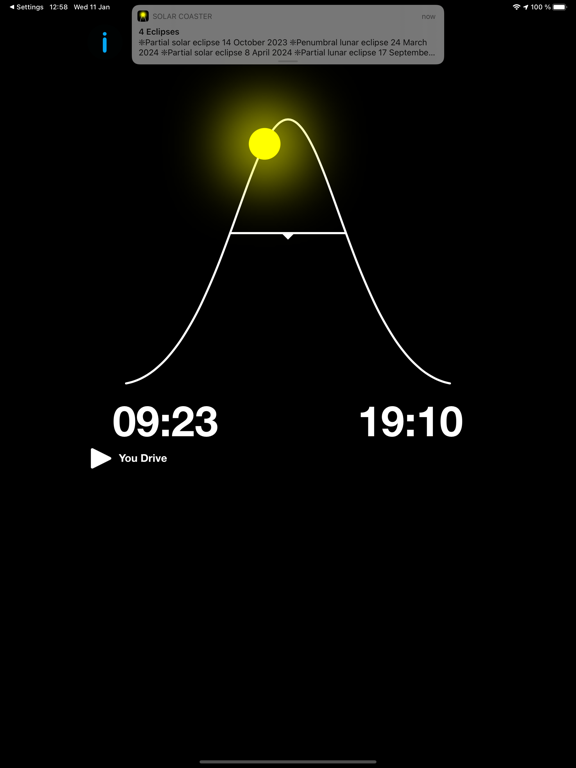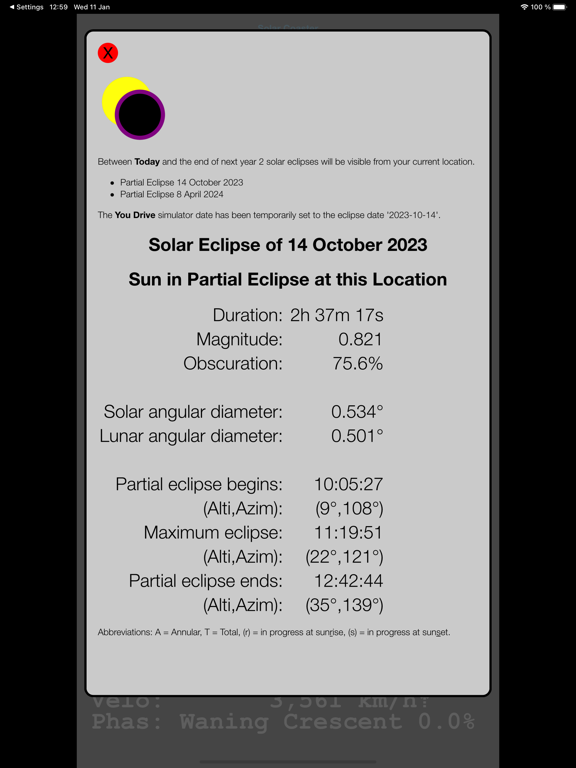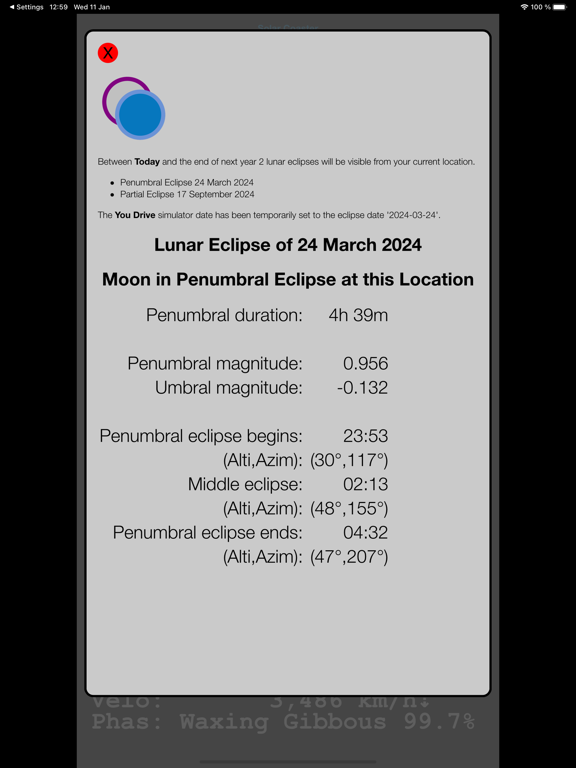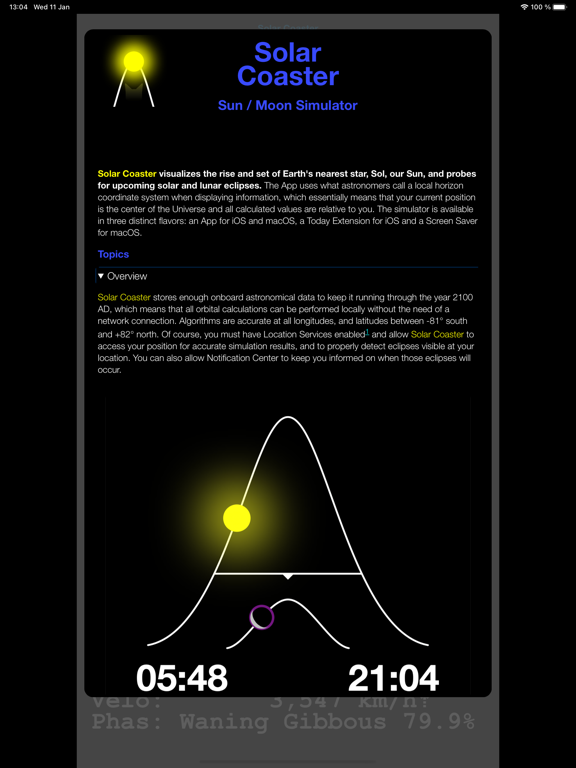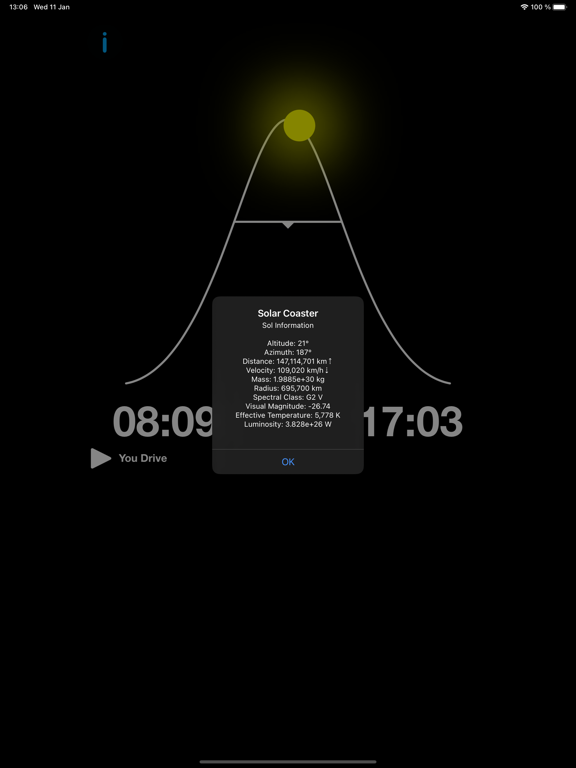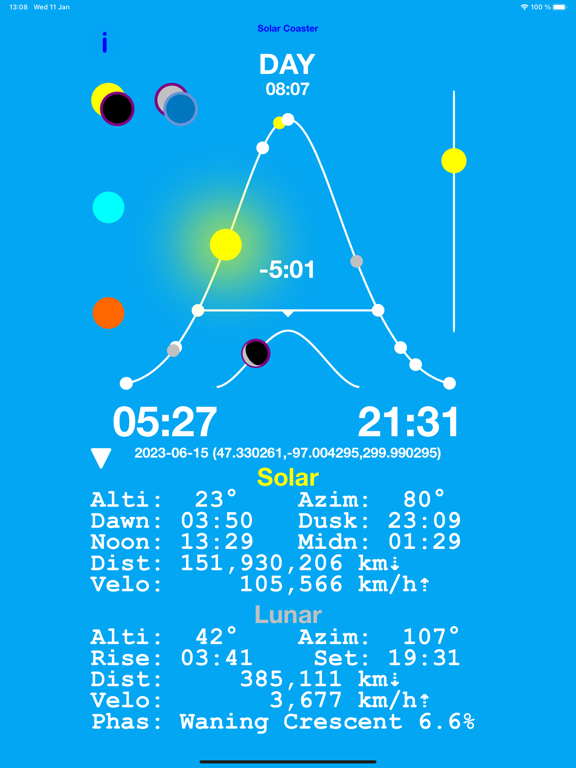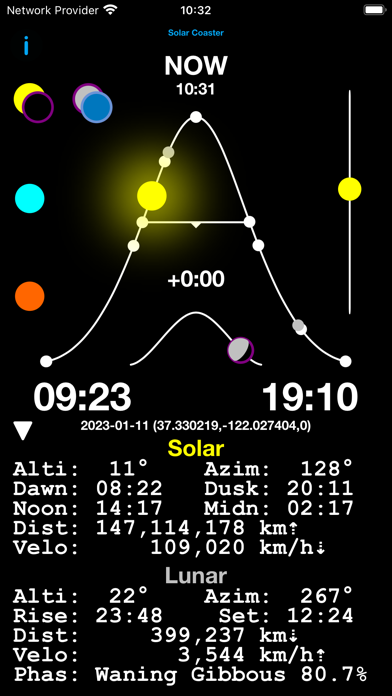
Solar Coaster
Free
4.0for iPhone, iPad and more
Age Rating
Solar Coaster Screenshots
About Solar Coaster
Solar Coaster visualizes the rise and set of Earth's nearest star, Sol, our Sun, and probes for upcoming solar and lunar eclipses. The App uses what astronomers call a local horizon coordinate system when displaying information, which essentially means that your current position is the center of the Universe and all calculated values are relative to you.
Solar Coaster's algorithms are accurate until 2100 AD, at all longitudes, and latitudes between -81° south and +82° north. Of course, you must have Location Services enabled and allow Solar Coaster to access your position for accurate simulation results, and to properly detect eclipses visible at your location.
A sinusoidal curve depicts Sol’s path for a single day, Today. An artificial, horizontal, horizon line is drawn such that it intersects the curve at precisely two points, Sunrise and Sunset. This means that all points on the curve above the horizon are Day, and those below are Night. As the lengths of the Day and Night change this horizon shifts up and down the sinusoidal curve, and a trend direction triangle indicates how the shift is moving. The actual Sunrise and Sunset times are also displayed, in 12 or 24-hour format.
The point exactly midway along the Day portion of the sinusoidal curve is called Solar Noon, and represents the time of day Sol is farthest above the horizon. Solar Noon typically does not coincide with 12 o’clock Noon.
The point exactly midway along the Night portion of the sinusoidal curve is called Solar Midnight, and represents the time of day Sol is farthest below the horizon. Solar Midnight typically does not coincide with 12 o’clock Midnight.
Dawn precedes Sunrise, and Dusk succeeds Sunset. During these times of Morning Twilight and Evening Twilight Sol slowly brightens and dims appropriately.
Earth's nearest celestial neighbor, Luna, our Moon, sometimes makes appearances during the visualization. At Moonrise a smaller, secondary, sinusoidal curve appears and Luna fades-in. Luna is drawn with its proper phase, and rotated to the precise phase angle. At Moonset Luna fades-out.
Touching either Sol or Luna displays a tiny bit of additional realtime information (unavailable for the Today Extension and Screen Saver).
Once a minute orbital calculations are performed and the visualization is updated. This means that if you are patient, very, very patient, you can watch Sol and Luna move! For those not so patient, touch the disclosure triangle and switch into manual You Drive mode (unavailable for the Today Extension and Screen Saver). The simulation is paused and the scene is augmented with informative data, various small, circular, marker points, three larger, colored, touch discs, Solar and Lunar Eclipse Probe controls, and a timer, which begins at +0:00, Now.
In You Drive mode:
⁃ Touching a marker displays its time (unavailable for the Today Extension and Screen Saver).
- Touching the horizon line's trend direction triangle displays the amount of daylight.
⁃ Touching the cyan disc animates the simulation through the special marker times, and those times only.
⁃ Touching the orange disc animates the simulation through the entire day of 1,440 minutes.
⁃ Touching and sliding the yellow disc animates the simulation to a random minute of the day.
- Touching an Eclipse Probe control initiates a search for upcoming solar or lunar eclipses, and if one is visible from your location the You Drive simulator is temporarily reset to that date and the eclipse circumstances are displayed.
The timer shows the elapsed time in hours and minutes of the simulation, whether positive or negative, relative to Now.
Touch the disclosure triangle once again to exit You Drive mode and resume the actual simulation. Don't be surprised if you notice the visualization catch up for lost time. And depending on what the time differential is and whether the simulation time is before or after Now, the tweening may be fast or slow or forward or reverse.
Solar Coaster's algorithms are accurate until 2100 AD, at all longitudes, and latitudes between -81° south and +82° north. Of course, you must have Location Services enabled and allow Solar Coaster to access your position for accurate simulation results, and to properly detect eclipses visible at your location.
A sinusoidal curve depicts Sol’s path for a single day, Today. An artificial, horizontal, horizon line is drawn such that it intersects the curve at precisely two points, Sunrise and Sunset. This means that all points on the curve above the horizon are Day, and those below are Night. As the lengths of the Day and Night change this horizon shifts up and down the sinusoidal curve, and a trend direction triangle indicates how the shift is moving. The actual Sunrise and Sunset times are also displayed, in 12 or 24-hour format.
The point exactly midway along the Day portion of the sinusoidal curve is called Solar Noon, and represents the time of day Sol is farthest above the horizon. Solar Noon typically does not coincide with 12 o’clock Noon.
The point exactly midway along the Night portion of the sinusoidal curve is called Solar Midnight, and represents the time of day Sol is farthest below the horizon. Solar Midnight typically does not coincide with 12 o’clock Midnight.
Dawn precedes Sunrise, and Dusk succeeds Sunset. During these times of Morning Twilight and Evening Twilight Sol slowly brightens and dims appropriately.
Earth's nearest celestial neighbor, Luna, our Moon, sometimes makes appearances during the visualization. At Moonrise a smaller, secondary, sinusoidal curve appears and Luna fades-in. Luna is drawn with its proper phase, and rotated to the precise phase angle. At Moonset Luna fades-out.
Touching either Sol or Luna displays a tiny bit of additional realtime information (unavailable for the Today Extension and Screen Saver).
Once a minute orbital calculations are performed and the visualization is updated. This means that if you are patient, very, very patient, you can watch Sol and Luna move! For those not so patient, touch the disclosure triangle and switch into manual You Drive mode (unavailable for the Today Extension and Screen Saver). The simulation is paused and the scene is augmented with informative data, various small, circular, marker points, three larger, colored, touch discs, Solar and Lunar Eclipse Probe controls, and a timer, which begins at +0:00, Now.
In You Drive mode:
⁃ Touching a marker displays its time (unavailable for the Today Extension and Screen Saver).
- Touching the horizon line's trend direction triangle displays the amount of daylight.
⁃ Touching the cyan disc animates the simulation through the special marker times, and those times only.
⁃ Touching the orange disc animates the simulation through the entire day of 1,440 minutes.
⁃ Touching and sliding the yellow disc animates the simulation to a random minute of the day.
- Touching an Eclipse Probe control initiates a search for upcoming solar or lunar eclipses, and if one is visible from your location the You Drive simulator is temporarily reset to that date and the eclipse circumstances are displayed.
The timer shows the elapsed time in hours and minutes of the simulation, whether positive or negative, relative to Now.
Touch the disclosure triangle once again to exit You Drive mode and resume the actual simulation. Don't be surprised if you notice the visualization catch up for lost time. And depending on what the time differential is and whether the simulation time is before or after Now, the tweening may be fast or slow or forward or reverse.
Show More
What's New in the Latest Version 4.0
Last updated on Jan 13, 2023
Old Versions
- Add instantaneous orbital velocity based on current distance.
- Add current moon phase name and illumination percentage.
- User interface and documentation improvements.
- Miscellanenous bug fixes.
- Minimum iOS version is 11.0 and minimum macOS version is 10.15.
- Update for iOS 16.1.1 and macOS 13.1.
- Add current moon phase name and illumination percentage.
- User interface and documentation improvements.
- Miscellanenous bug fixes.
- Minimum iOS version is 11.0 and minimum macOS version is 10.15.
- Update for iOS 16.1.1 and macOS 13.1.
Show More
Version History
4.0
Jan 13, 2023
- Add instantaneous orbital velocity based on current distance.
- Add current moon phase name and illumination percentage.
- User interface and documentation improvements.
- Miscellanenous bug fixes.
- Minimum iOS version is 11.0 and minimum macOS version is 10.15.
- Update for iOS 16.1.1 and macOS 13.1.
- Add current moon phase name and illumination percentage.
- User interface and documentation improvements.
- Miscellanenous bug fixes.
- Minimum iOS version is 11.0 and minimum macOS version is 10.15.
- Update for iOS 16.1.1 and macOS 13.1.
3.6
Aug 16, 2022
- Improve Solar Coaster behavior in low memory conditions.
- Minor bug fixes and improvements.
- Minimum iOS version is 10.0 and minimum macOS version is 10.15.
- Update for iOS 15.6 and macOS 12.5.
- Minor bug fixes and improvements.
- Minimum iOS version is 10.0 and minimum macOS version is 10.15.
- Update for iOS 15.6 and macOS 12.5.
3.5
Mar 31, 2022
- Fix, finally, the jarring "white flash" at startup for the macOS App and Screen Saver.
- The iOS and macOS Apps can, with your permission, post summary eclipse data to the Notification Center. This means you can badge the App's icon with an eclipse count, or list the eclipses in Notification Center, or both. Or neither, controllable in iOS Settings and macOS System Preferences.
- The eclipse summary is refreshed automatically once daily.
- The Refine Position Every Minute Preference has now been implemented in the macOS App and Screen Saver.
- The Location Override Preference has now been implemented in the macOS Screen Saver.
- Although the macOS Screen Saver cannot post an eclipse summary in Notification Center, it does show the summary in Screen Saver Options..., under the new tab Eclipses.
- The macOS App can now export its matching Screen Saver with the new Export Screen Saver menu item.
- Minimum iOS version is 10.0 and minimum macOS version is 10.14.
- Minor bug fixes and improvements.
- Update for iOS 15.4 and macOS 12.3.
- The iOS and macOS Apps can, with your permission, post summary eclipse data to the Notification Center. This means you can badge the App's icon with an eclipse count, or list the eclipses in Notification Center, or both. Or neither, controllable in iOS Settings and macOS System Preferences.
- The eclipse summary is refreshed automatically once daily.
- The Refine Position Every Minute Preference has now been implemented in the macOS App and Screen Saver.
- The Location Override Preference has now been implemented in the macOS Screen Saver.
- Although the macOS Screen Saver cannot post an eclipse summary in Notification Center, it does show the summary in Screen Saver Options..., under the new tab Eclipses.
- The macOS App can now export its matching Screen Saver with the new Export Screen Saver menu item.
- Minimum iOS version is 10.0 and minimum macOS version is 10.14.
- Minor bug fixes and improvements.
- Update for iOS 15.4 and macOS 12.3.
3.4
Feb 7, 2022
- For iOS only, add a new Setting named Refine Position Every Minute. By default your location is determined once, at startup. But when chasing an eclipse it has proven convenient to update the device's position on-the-fly to keep calculations as accurate as possible.
- Minor bug fixes and improvements.
- Update for iOS 15.3, macOS 12.2.
- Minor bug fixes and improvements.
- Update for iOS 15.3, macOS 12.2.
3.3
Apr 3, 2021
- Tween bug fix: sometimes the animation would stop at solar midnight.
- Protect against NaN while computing Luna's orbital path.
- New macOS Universal binary that runs on either Apple Silicon or Intel Macs.
- Update for iOS 14.4.2 and macOS 11.2.3.
- Protect against NaN while computing Luna's orbital path.
- New macOS Universal binary that runs on either Apple Silicon or Intel Macs.
- Update for iOS 14.4.2 and macOS 11.2.3.
3.2
Jul 26, 2020
- Protect against NaN while computing Sol's orbital path.
- Fix display update issue after returning from the background.
- Update for iOS 13.6 and macOS 10.15.6.
- Fix display update issue after returning from the background.
- Update for iOS 13.6 and macOS 10.15.6.
3.1
Jun 4, 2020
- New dynamic background theme OS Appearance that switches between themes Day and Night depending upon the operating system light / dark appearance. If the operating system doesn't support appearances then the old-style light appearance is used.
- Update for iOS 13.5.1.
- Update for iOS 13.5.1.
3.0
Mar 4, 2020
- Location information now includes the Z-coordinate, altitude, for more refined time calculations.
- If location services are inaccurate or unavailable, the iOS and macOS Apps allow you to manually specify the simulator's latitude, longitude and altitude.
- Orbital calculations are now accurate through 2100 AD.
- Minor bug fixes.
- Update for iOS 13.3.1 and macOS 10.15.3.
- If location services are inaccurate or unavailable, the iOS and macOS Apps allow you to manually specify the simulator's latitude, longitude and altitude.
- Orbital calculations are now accurate through 2100 AD.
- Minor bug fixes.
- Update for iOS 13.3.1 and macOS 10.15.3.
2.1
Mar 24, 2019
- Lunar eclipse bug fix.
- Update for macOS 10.14.3 and iOS 12.1.4.
- Documentation now supports BigCatOs Appearances.
- Update for macOS 10.14.3 and iOS 12.1.4.
- Documentation now supports BigCatOs Appearances.
2.0
Nov 1, 2018
- In addition to the existing Solar Eclipse Probe, there is a new Lunar Eclipse Probe. Get ready for the next Lunar eclipse in your area!
- All orbital calculations are done on-device, network connectivity is no longer required.
- Extensive documentation and information display changes.
- Update for iOS 12.1.
- Even a bug fix or so.
- All orbital calculations are done on-device, network connectivity is no longer required.
- Extensive documentation and information display changes.
- Update for iOS 12.1.
- Even a bug fix or so.
1.8
Sep 18, 2018
- Upate for iOS 12.0.
- Documentation updates.
- Documentation updates.
1.7
Jan 2, 2018
- Improve background / foreground transitions.
- Improve handling of the You Drive minute of the day slider.
- Improve handling of the You Drive minute of the day slider.
1.6
Dec 4, 2017
- Update for iOS 11.2 and iPhone X.
- DST fix.
- DST fix.
1.5
Oct 26, 2017
- Update for iOS 11.0.3.
1.4.1
Aug 8, 2017
- Website redesign requires conforming documentation updates.
1.4
Jul 24, 2017
- Generalize solar eclipse code: add an Eclipse Explorer control to You Drive mode that looks ahead for solar eclipses and, if visible from your location, displays local eclipse circumstances.
- Update for iOS 10.3.3.
- Update for iOS 10.3.3.
1.3
Jul 10, 2017
- New code for the August 21, 2017 solar eclipse, which displays eclipse circumstances for your location on the day of the event.
- Additional real-time data displayed in You Drive mode, such as distance, altitude, azimuth, date and GPS coordinates.
- Trend indicators for Sol and Luna distances, and the horizontal artificial horizon line that measures the hours of daylight.
- Performance and memory footprint enhancements.
- Additional real-time data displayed in You Drive mode, such as distance, altitude, azimuth, date and GPS coordinates.
- Trend indicators for Sol and Luna distances, and the horizontal artificial horizon line that measures the hours of daylight.
- Performance and memory footprint enhancements.
1.2
May 8, 2017
- Today Extension inherits settings from the Solar Coaster App.
- Implement Now marker.
- Bug fixes.
- Implement Now marker.
- Bug fixes.
1.1
Apr 20, 2017
- Enhance New Day transition.
- Add Twilight Background theme.
- Bug fixes.
- Add Twilight Background theme.
- Bug fixes.
1.0
Apr 4, 2017
Solar Coaster FAQ
Click here to learn how to download Solar Coaster in restricted country or region.
Check the following list to see the minimum requirements of Solar Coaster.
iPhone
Requires iOS 11.0 or later.
iPad
Requires iPadOS 11.0 or later.
Mac
Requires macOS 10.15 or later.
iPod touch
Requires iOS 11.0 or later.
Solar Coaster supports English
Related Videos
Latest introduction video of Solar Coaster on iPhone

